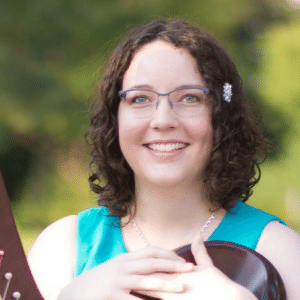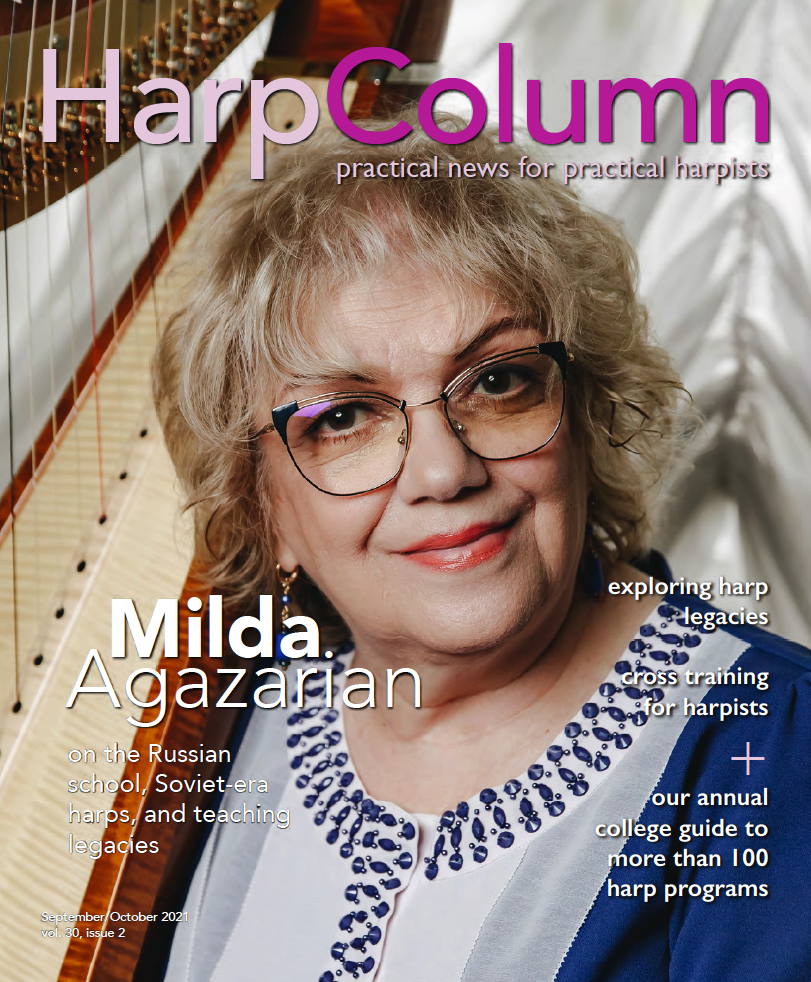In the last couple months, I’ve had fun discovering the history and heritage that all harpists share. As I read the books for the second article in our four-part series exploring good harp reads, I was intrigued by the breadth of cultures that the harp represents, and the creativity of harp makers from all traditions. Famous harpists like Henriette Renié, Marcel Grandjany, and Carlos Salzedo became more real to me as I saw how the combined weight of their achievements created the opportunities that I and other harpists have today. I also found unexpected inspiration through the courage of one woman whose career paved the way for many others.
Harps and Harpists
by Roslyn Rensch; rev. 2007

Roslyn Rensch’s classic book Harps and Harpists (revised in 2007) “includes such a wonderful exploration of the evolution of the harp from its first artistic renderings to development of the classical harp,” says Dr. Angela Schwarzkopf, winner of the 2020 JUNO Award for Classical Album of the Year: Solo or Chamber Music. “I first started reading her book during my doctorate research and have found that I return to it again and again even today.” Former Vancouver Symphony Orchestra principal harpist Elizabeth Volpé Bligh agrees, “Every harpist should have it in their library.” Minnesota-based harpist Stephanie Claussen adds that Harps and Harpists is an enjoyable way to “put names and types of harps into their historical context.”
Alongside dozens of detailed illustrations, Rensch traces the development of the harp from the earliest civilizations to the present. She focuses on aspects of the harp’s construction, geographical and historical differences in playing techniques, representations in art and literature, growth of significant repertoire, innovations by harp makers, and selected events in the harp world. Throughout the text, Rensch suggests additional resources—including books, recordings, illustrations, and research publications—for harpists interested in exploring further.
One Stone to the Building
by Jaymee Haefner
Henriette Renié: Living Harp
by Françoise des Varennes

Dr. Jaymee Haefner’s eloquently informative biography One Stone to the Building: Henriette Renié’s LifeThrough Her Works for Harp heightened my understanding of the immense debt that all harpists owe to Henriette Renié’s brilliance as a virtuoso, composer, and teacher. I was once again amazed to read about her tireless advocacy for the harp’s vibrant musical potential as a solo instrument, her substantial additions to the harp’s repertoire, and her lasting contribution to harp technique through her method book and teaching pieces.
One Stone to the Building is valuable not only as a biography, but also as a clearly presented guide to Renié’s thought process as a composer and transcriber. Haefner discusses the compositional features and historical influence of Renié’s compositions, including Légende, Deux promenades matinales, Concerto en ut mineur, and Scherzo-Fantaisie, along with Renié’s transcriptions of Tic-toc-choc ou les maillotins by François Couperin and Moment musical no. 3 in F Minor, op. 94, by Franz Schubert. Haefner also includes a helpful analysis of Méthode complète pour harpe, summarizing its pedagogical structure and showing how Renié skillfully and thoroughly addressed the harp’s technique.
I heard about One Stone to the Building from Laura Sherman, who teaches at the Frost School of Music at the University of Miami and whose performing career ranges from classical to Broadway. Sherman concludes, “Whether you are a performer or teacher, this book is invaluable in understanding the legacy and lineage of this important harpist.”

For a short and witty account of Renié’s personality and family relationships, try Henriette Renié: Living Harp by Françoise des Varennes, Renié’s goddaughter. Her stories illuminate Renié’s audacious, yet humble and generous, spirit. Renié not only fought to make the harp welcome on the concert stage, but she also impacted the world by influencing the character of generations of harpists through her devoted teaching. She also cared for her family, friends, and fellow artists, encouraging them and supporting them with whatever income she had. Usually I think of Renié as a great harpist and teacher, but this book helped me see her as a person with a feisty personality, a tenacious soul, and a love of life.
Marcel Grandjany: Concert Harpist, Composer, and Teacher
by Ruth K. Inglefield

Renié’s most famous students, Marcel Grandjany and Carlos Salzedo, continued her legacy of teaching and composition into the twentieth century. Kathy Kienzle, a student of Marcel Grandjany and former principal harpist of the Minnesota Orchestra, says that Ruth K. Inglefield’s book about Grandjany and Dewey Owens’ biography of Salzedo “are important for all harpists to understand two of our greatest harpist-composers.”
Ruth K. Inglefield’s Marcel Grandjany: Concert Harpist, Composer, and Teacher is a brief collection of eyewitness accounts, photographs, and quotations from Grandjany and those who knew him well. Inglefield’s narration ties the individual documents together and explains their significance in history. These firsthand experiences of Grandjany’s musicianship will draw you in.
The book is clearly organized in four parts. The first part traces Grandjany’s career and the struggles he faced as one of the pioneer soloists of the harp. Part two provides insight into Grandjany’s way of structuring his concert programs, along with critics’ responses to his groundbreaking solo harp recitals. The third part describes Grandjany’s compositional style and his viewpoint on transcriptions. The conclusion, a series of reminiscences by his students, is the most personal window into Grandjany’s character.
Carlos Salzedo: From Aeolian to
Thunder, a Biography
by Dewey Owens

Carlos Salzedo: From Aeolian to Thunder, a Biography gives a big-picture perspective of Salzedo’s world and an intimate portrait of Salzedo within the broader music community. The diversity of his talents, interests, and influence is astonishing. Salzedo was a giant in modern music, not just as a harpist and teacher, but also as a composer and innovator.
I appreciated Dewey Owens’ sense of humor as he blends biographical details with entertaining stories. Owens includes a variety of engaging original documents, including excerpts of Salzedo’s manuscripts and letters, black-and-white photographs, and telegram exchanges. Each chapter uncovers unexpected details. After reading this book, I have a better understanding of Salzedo’s personality, his contribution to the music world, and his enigmatic life.
One Woman in a Hundred
by Mary Sue Welsh

One Woman in a Hundred is a striking portrait of Edna Phillips, principal harpist of the Philadelphia Orchestra and the first female principal player in a major American orchestra. Author Mary Sue Welsh captures Phillips’ spunky personality and independent voice.
I was amazed to realize that women in professional careers faced so much hostility a century ago. I also enjoyed learning about different conductors at their most brilliant and their most flawed. I loved meeting “the characters who populated the Philadelphia Orchestra at the time,” in the words of Elizabeth Volpé Bligh. “I had some lessons with Edna Phillips when I went to the Salzedo Harp Colony,” Volpé Bligh recalls. “The story of how she got the job, and managed to thrive while being the only female member of the orchestra, is very inspiring.”
Reading about the undeniable legacies of these harpists has changed my priorities. I’ve begun to understand the harp world in a different way after seeing what mattered to these harpists, and what they fought to change during their careers. Many of these issues are the same today: transcribing and commissioning new repertoire, mentoring students, seeking excellence as performers, and overcoming discrimination based on gender or race. It’s up to our generation of harpists to carry on their legacies and keep pursuing their ideals. •






